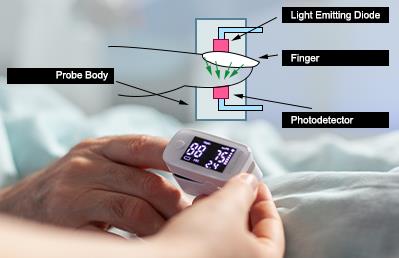Save 25% On Your First Autoship Order
Save 25% On Your First Autoship Order

With respiratory viruses such as COVID-19 dominating the news headlines, it has never been more important to be prepared for when a respiratory virus heads your way. Our respiratory system is especially important in transporting oxygen throughout our body. One of the negative impacts of any respiratory virus is the diminishing distribution of oxygen to our cells in our bodies. One effective device we can use to monitor the saturation of oxygen in our blood system is pulse oximeters. So, what exactly are these devices and what does pulse oximetry actually do for us? We here at HPFY can give you the facts about pulse oximetry and its benefits.

Our body requires oxygen, this is not debatable. This oxygen that we inhale into our lungs is then transported via our red blood cells (hemoglobin) throughout our body. It is critical that we maintain proper oxygen saturation levels in our blood so that the oxygen levels are sufficient to maintain healthy cells throughout our body. Respiratory infections can diminish this oxygen saturation level in our blood and cause problems that may require supplemental oxygen therapy or worse. Pulse oximetry can be useful in diagnosing conditions such as:
Being able to determine what your blood oxygen levels are can help the medical professionals prescribe supplemental oxygen therapy or other interventions in order to help our lungs pass along needed oxygen to our bodies.
Believe it or not, monitoring your blood oxygen levels at home is amazingly simple and easy. A little medical device called a pulse oximeter is all you need. These easy to use, inexpensive fingertip devices can give you your blood oxygen levels in the palm of your hand (forgive the pun). There are no preparations for this type of test and it is completely noninvasive. About the only thing you need to do is to remove nail polish you may have on your fingernails. In order to test your oxygen levels in your blood, simply clip the pulse oximeter to your fingertip and let it do its magic. A normal oxygen saturation level is around 95%. When levels drop to around 92% or less, a condition known as hypoxemia occurs. This may indicate the need for supplemental oxygen therapy. A pulse oximeter works by:

It is this change in the light waves that determine your blood oxygen saturation levels as well as your pulse. This type of test has no risks or side effects associated with it. These little gems are a great way to determine that the O2 in your lungs makes it into our bloodstream and circulates it throughout our body.
Pulse oximetry and oximeters are a crucial addition to your medicine cabinets to help us stay healthy from respiratory maladies. These are small, inexpensive meters that don’t take up a lot of space and are incredibly easy to use. You can choose from the 6 Best Pulse Oximeters for Home Use. Clip on and be well!!
Disclaimer: All content found on our website, including images, videos, infographics and text were created solely for informational purposes. Our content should never be used for the purpose of diagnosis or treatment of any medical conditions. Content shared on our websites is not meant to be used as a substitute for advice from a certified medical professional. Reliance on the information provided on our website as a basis for patient treatment is solely at your own risk. We urge all our customers to always consult a physician or a certified medical professional before trying or using a new medical product.

Kevin Cleary has been a Health Products For You contributor for many years and has a degree in marketing. His health and wellness journey has a very personal meaning and has guided him in his content writing for HPFY.
In 2006, ...
How To Increase Iron Levels Quickly
It’s a question that must have puzzled you like many others. Iron is essential in hemoglobin production and its inadequate levels can negatively impact your health. Dive into this informative article to explore top iron-rich foods that can help you fight iron deficiency.
10 Best Coccyx Cushions for Tailbone Pain
If you're like most people, you spend about 8 to 10 hours sitting every day. However unhealthy, it is part of life for many, and can cause tailbone pain. Coccyx cushions can help alleviate this pain. Click to read more and find the perfect coccyx cushion for your tailbone pain.
5+ Best Adult Diapers for Fecal Incontinence
Dealing with fecal incontinence can be challenging, but you're not alone. Read this article and navigate through discreet and effective solutions that help you manage fecal incontinence and let you live life on your terms with confidence and comfort.
Top 5 Best Reviewed Nebulizers of 2024
Need an effective and affordable nebulizer? Look no further, in this article we offer 5 of our best reviewed nebulizers that are loved by our customers. Click to read more and find the perfect nebulizer for all your respiratory needs.
10 Best Penis Pumps For Erectile Dysfunction
For anyone dealing with erectile dysfunction, penis pumps serve as a great way to manage it. But with so many products available, determining the best one for your needs can be challenging. To assist you in refining your choices and making an informed decision, here are our top 10 options, recognized for their effectiveness and safety.